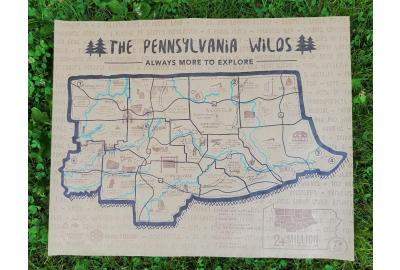“Hey, it’s Elk County, not Elk Country! This place he’s talking about is nowhere near the Pine Creek Valley! And what is this I-80 Frontier thing, anyway?”
I get comments like that almost every time I write an article about the Pennsylvania Wilds. Whenever I mention the landscapes, and their names, there’s always someone who doesn’t quite understand what I’m talking about. And mainly, it’s because a lot of people are unfamiliar with the territory of the Pennsylvania Wilds and the landscapes within.
The Pennsylvania Wilds is a tourism region in Pennsylvania, one of several in the state. It covers twelve and a half counties in the north-central and northwestern part of the state. Within this area, the land is subdivided into six other regions, called landscapes. Each one has its own special sights and characteristics, so that each landscape carries a unique experience.
To help inform some of the people who’ve never encountered this before, I’ve written this guideline to the landscapes. If you’re interested, it might be worth getting a copy of the Pennsylvania Wilds Outdoor Discovery Atlas, available at the PA Wilds stores and online.
I-80 Frontier


The I-80 Frontier is one of my favorites, mainly because it’s where I live. It runs across the southern end of the PA Wilds, covering the lower part of Clinton, Clearfield, Lycoming, and Clarion Counties, and the top half of Centre. It provides easy access to the rest of the Wilds, with Interstate 80 running across it.
The I-80 Frontier is arguably the most diverse landscape in terms of tourism, because it covers so much area. It has museums, such as the Little League Museum in Williamsport and the Piper Aviation Museum in Lock Haven. It has state parks, such as Ravensburg, Bald Eagle, and Black Moshannon. Millbrook Playhouse in Mill Hall and the Community Arts Center in Williamsport provide theater opportunities. And hiking trails cover the landscape, some only a few minutes’ drive from the interstate.
If you’re looking for a varied experience in the PA Wilds, with opportunities for different things to do and see, the I-80 Frontier is a great place to visit.
Pine Creek Valley and the PA Grand Canyon


This landscape covers parts of Tioga and Lycoming Counties, its southern border ending just north of Williamsport. The name of this landscape explains the main attractions: the Pine Creek Valley, and the 45-mile long Pennsylvania Grand Canyon. This landscape forms the northeast corner of the PA Wilds.
There are plenty of opportunities for outdoor activity here, including hiking and biking. The Pine Creek Rail Trail runs through this landscape, stretching across the counties to make a long and scenic bike ride. Little Pine State Park is in this landscape, as well, and that makes a great camping experience.
Dark Skies


The Dark Skies landscape gets its name, obviously, from the dark skies that are there. Covering portions of Potter, Tioga, Lycoming, and Clinton Counties, it is home to Cherry Springs State Park, the perfect place for stargazing. Far from any light pollution, Cherry Springs is the farthest place from light in the state, making it a great place to sit and look at the stars.
But that’s not all there is to the Dark Skies Landscape. There are other state parks, such as Ole Bull and Kettle Creek, which are marvelous places to visit. There are hiking and biking paths, including the Donut Hole Trail and the Black Forest Trail, and the Bucktail Scenic Byway, a hundred-mile long scenic drive that winds through several of these landscapes. This includes….
Elk Country


Though Elk County is clearly a part of Elk Country, it’s not the only county included. The landscape also covers parts of Clinton, Clearfield, and Cameron Counties. Elk Country is the central portion of the Pennsylvania Wilds, lying in between all the other landscapes. It’s named for the local elk, which are a big attraction in the area.
If you take a trip along the Elk Scenic Drive, you’re likely to see some of the elk along the way. But that’s not all. Hyner View State Park provides one of the best scenic views in the area, and the Eagleton Mine Camp Trail goes through the ruins of old mining communities. If you’re looking for camping, Elk Country is a great place to go, with plenty of state parks, including Bendigo, Parker Dam, and of course, Elk.
(Also, my editor lives in the Elk Country landscape, so here’s hoping for brownie points.)
Allegheny National Forest and Surrounds


As the name suggests, this landscape covers the Allegheny National Forest and the surrounding areas, and is the northwestern corner of the Wilds. It covers Warren and McKean Counties, and part of Forest County.
Like the other landscapes, there are opportunities for outdoor activity, but also some unique points. The Kinzua Bridge is one of these. Once the world’s longest railroad bridge, the Kinzua Bridge has been reworked into a skywalk after having been badly damaged in 2003. Visitors can walk out onto the viewing area and look out over the valley, and then visit the wonderfully kid-friendly visitors’ center nearby.
If you’re looking for a museum experience, this landscape has that too. The Penn Brad Oil Museum and the Zippo/Case Museum are both in Bradford, and showcase these industries from the area.
Cook Forest and the Ancients


Cook Forest and the Ancients, geographically the smallest of the landscapes, is wedged in between the I-80 Frontier and Allegheny National Forest and Surrounds, composed of parts of Clarion and Forest Counties. As the name would suggest, the main attraction is Cook Forest State Park, where visitors can view the Forest Cathedral, which holds amazing old-growth trees.
This landscape also is home to the Clarion River, making it a great place for fishing and boating.
These six landscapes and their points of interest have always intrigued me, and I encourage people to visit. For further information, pick up a copy of the Pennsylvania Wilds Outdoor Discovery Atlas and find your favorite artist in each landscape! You won’t regret it.
About the Author
Lou Bernard is a freelance writer, historian, explorer, outdoor enthusiast, and paranormal investigator. A resident of Clinton County, Lou is a staff member at the Annie Halenbake Ross Library. He is a member of the Lock Haven Paranormal Seekers, and investigates old legends and stories from the past.







